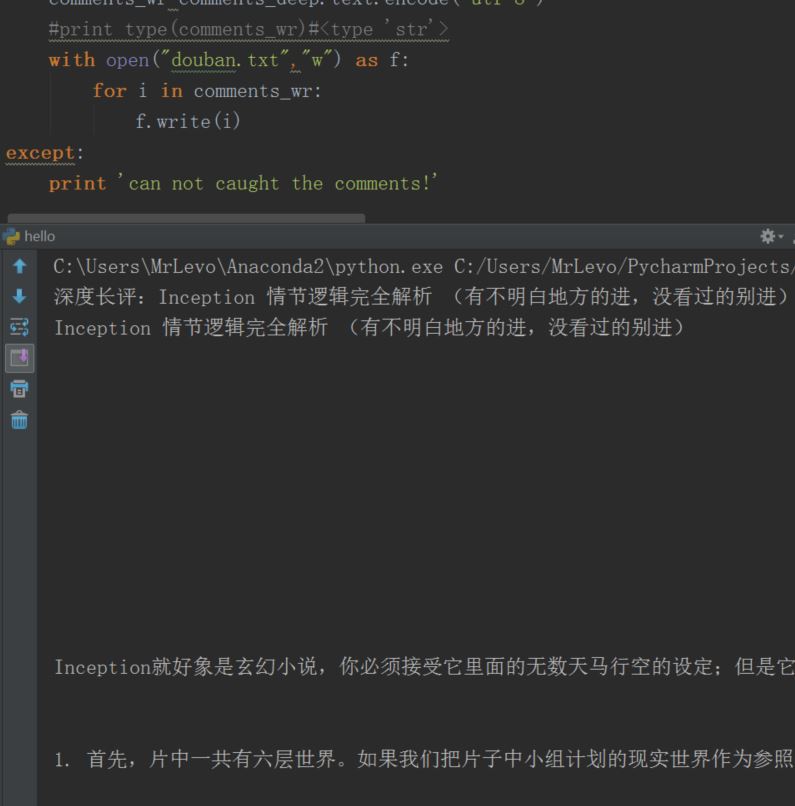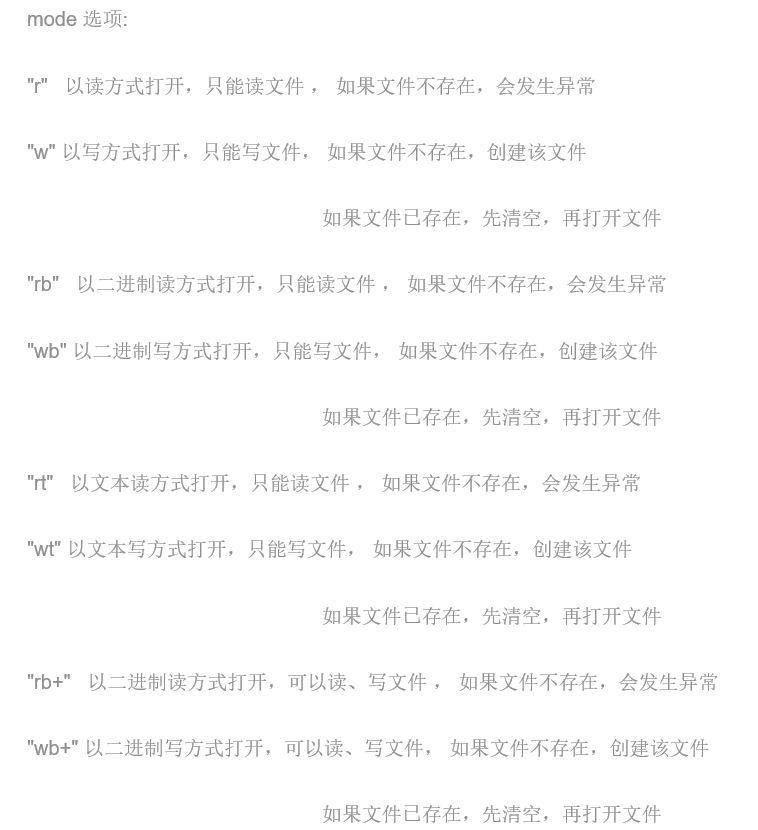How to write a file in python to TXT
This article mainly introduces how to write files in python to TXT. The editor thinks it is quite good, so I will share it with you now and give it as a reference. Let’s follow the editor and take a look.
1. Write the txt yourself
Directly upload the core code:
with open("douban.txt","w") as f:
f.write("这是个测试!")This sentence comes with its own file Close function, so it is more pythontic than those methods of opening first, then writing and then closing!
The result is like this:

2. Write the content of the file input (print) into txt
I don’t I like handwriting characters. What I mostly use is to write the prints from the program into txt and save them. For example, I just grabbed the content from Douban and I want to write it in. How should I save it? This uses a for loop. Regarding Douban crawling, please see my previous blog
I just want to save the text in the output box
#分模块测试,txt写入测试
# -*- coding: utf-8 -*-
from selenium import webdriver
import selenium.webdriver.support.ui as ui
import time
#driver_item=web
driver.Firefox()driver_item=webdriver.PhantomJS(executable_path="phantomjs.exe")
url="https://movie.douban.com/subject/3541415/?tag=%E7%A7%91%E5%B9%BB&from=gaia_video"
wait = ui.WebDriverWait(driver_item,10)
driver_item.get(url)
try:
driver_item.find_element_by_xpath("//img[@class='bn-arrow']").click()
#wait.until(lambda driver: driver.find_element_by_xpath("//p[@class='review-bd']/p[2]/p/p"))
time.sleep(1)
comments_deep = driver_item.find_element_by_xpath("//p[@class='review-bd']/p[2]/p")
print u"深度长评:"+comments_deep.text
#print type(comments_deep.text)#<type 'unicode'>
comments_wr=comments_deep.text.encode('utf-8')
#print type(comments_wr)#<type 'str'>
#title="盗梦空间"#中文命名文件名乱码,内容可用 title="Inception"
with open("%s.txt"%title,"w") as f:#格式化字符串还能这么用!
for i in comments_wr:
f.write(i)
except:
print 'can not caught the comments!'More commonly used MODE

Do not clear continuous writing
It will be automatically created when there is no file, but! If I write this again, it will be cleared first and then written again, which means that what was written before is gone. Isn't this bad? I have to record a lot of things, and the omnipotent a appears. . .
Just change the core code to this. Remember to change w to a. As for the dividing line problem, because subsequent writing will be mixed with the previous ones, I use:
with open("%s.txt"%title,"a") as f:#格式化字符串还能这么用!
f.write("\n-------------------------------------我是分割线-----------------------------------------\n")
for i in comments_wr:
f.write(i)The effect is like this, if it’s not good enough, I’ll add more details, such as more line breaks

##That’s all
The above is the detailed content of How to write a file in python to TXT. For more information, please follow other related articles on the PHP Chinese website!

Hot AI Tools

Undresser.AI Undress
AI-powered app for creating realistic nude photos

AI Clothes Remover
Online AI tool for removing clothes from photos.

Undress AI Tool
Undress images for free

Clothoff.io
AI clothes remover

Video Face Swap
Swap faces in any video effortlessly with our completely free AI face swap tool!

Hot Article

Hot Tools

Notepad++7.3.1
Easy-to-use and free code editor

SublimeText3 Chinese version
Chinese version, very easy to use

Zend Studio 13.0.1
Powerful PHP integrated development environment

Dreamweaver CS6
Visual web development tools

SublimeText3 Mac version
God-level code editing software (SublimeText3)

Hot Topics
 1677
1677
 14
14
 1431
1431
 52
52
 1334
1334
 25
25
 1280
1280
 29
29
 1257
1257
 24
24
 PHP and Python: Different Paradigms Explained
Apr 18, 2025 am 12:26 AM
PHP and Python: Different Paradigms Explained
Apr 18, 2025 am 12:26 AM
PHP is mainly procedural programming, but also supports object-oriented programming (OOP); Python supports a variety of paradigms, including OOP, functional and procedural programming. PHP is suitable for web development, and Python is suitable for a variety of applications such as data analysis and machine learning.
 Choosing Between PHP and Python: A Guide
Apr 18, 2025 am 12:24 AM
Choosing Between PHP and Python: A Guide
Apr 18, 2025 am 12:24 AM
PHP is suitable for web development and rapid prototyping, and Python is suitable for data science and machine learning. 1.PHP is used for dynamic web development, with simple syntax and suitable for rapid development. 2. Python has concise syntax, is suitable for multiple fields, and has a strong library ecosystem.
 How to run sublime code python
Apr 16, 2025 am 08:48 AM
How to run sublime code python
Apr 16, 2025 am 08:48 AM
To run Python code in Sublime Text, you need to install the Python plug-in first, then create a .py file and write the code, and finally press Ctrl B to run the code, and the output will be displayed in the console.
 PHP and Python: A Deep Dive into Their History
Apr 18, 2025 am 12:25 AM
PHP and Python: A Deep Dive into Their History
Apr 18, 2025 am 12:25 AM
PHP originated in 1994 and was developed by RasmusLerdorf. It was originally used to track website visitors and gradually evolved into a server-side scripting language and was widely used in web development. Python was developed by Guidovan Rossum in the late 1980s and was first released in 1991. It emphasizes code readability and simplicity, and is suitable for scientific computing, data analysis and other fields.
 Golang vs. Python: Performance and Scalability
Apr 19, 2025 am 12:18 AM
Golang vs. Python: Performance and Scalability
Apr 19, 2025 am 12:18 AM
Golang is better than Python in terms of performance and scalability. 1) Golang's compilation-type characteristics and efficient concurrency model make it perform well in high concurrency scenarios. 2) Python, as an interpreted language, executes slowly, but can optimize performance through tools such as Cython.
 How to run python with notepad
Apr 16, 2025 pm 07:33 PM
How to run python with notepad
Apr 16, 2025 pm 07:33 PM
Running Python code in Notepad requires the Python executable and NppExec plug-in to be installed. After installing Python and adding PATH to it, configure the command "python" and the parameter "{CURRENT_DIRECTORY}{FILE_NAME}" in the NppExec plug-in to run Python code in Notepad through the shortcut key "F6".
 Golang vs. Python: Key Differences and Similarities
Apr 17, 2025 am 12:15 AM
Golang vs. Python: Key Differences and Similarities
Apr 17, 2025 am 12:15 AM
Golang and Python each have their own advantages: Golang is suitable for high performance and concurrent programming, while Python is suitable for data science and web development. Golang is known for its concurrency model and efficient performance, while Python is known for its concise syntax and rich library ecosystem.
 Python vs. C : Learning Curves and Ease of Use
Apr 19, 2025 am 12:20 AM
Python vs. C : Learning Curves and Ease of Use
Apr 19, 2025 am 12:20 AM
Python is easier to learn and use, while C is more powerful but complex. 1. Python syntax is concise and suitable for beginners. Dynamic typing and automatic memory management make it easy to use, but may cause runtime errors. 2.C provides low-level control and advanced features, suitable for high-performance applications, but has a high learning threshold and requires manual memory and type safety management.




